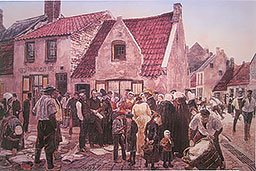This tendency surfaces even in Skarbina’s Double Study of a Fisherman (see previous page), a preparatory study for the multi-figural painting Fish-market in Blankenberghe (Fig. 1) in which the artist portrays a scene from everyday life in this Belgian coastal town. First presented in 1886 at the anniversary exhibition of the Royal Academy of Arts in Berlin, this picture earned Skarbina an honorable mention in the field of painting, which served as a prelude to a long string of national and international accolades that reflected the public recognition, which the artist experienced throughout his life. The street scene Houses in Blankenberghe (see next page), created two years prior, was likewise integrated into the picture described above. These preparatory studies for the Fishmarket were presented to the Berlin Artists’ Association during the summer of 1887 to generally positive response. Writing for the journal Kunstchronik, Adolf Rosenberg therefore emphasized that Skarbina “incorporated nature studies directly into his image without significant alteration or rewriting” in a way that enabled one to conclude that his manner of creation was “directly established upon the closest of contact with nature.” In doing so, Skarbina forayed into new artistic territory, for his realistic approach — based upon the tradition of the Berlin school of painting — stood diametrically opposed to the romanticizing pictorial language represented, for instance, within the Düsseldorf school of painting by Andreas Achenbach’s (1815-1910) atmospherically-charged painting Fishmarket in Ostend.

